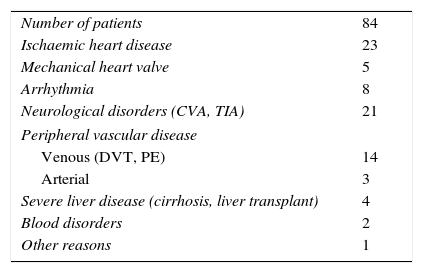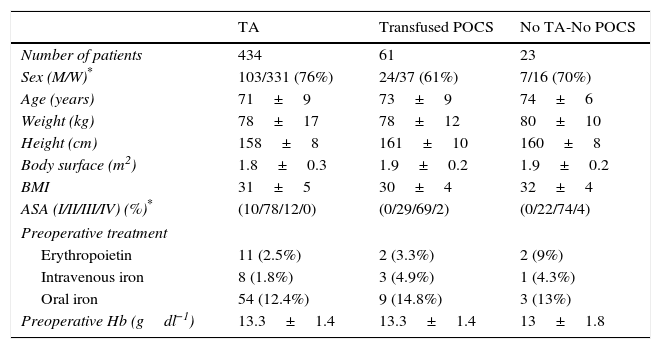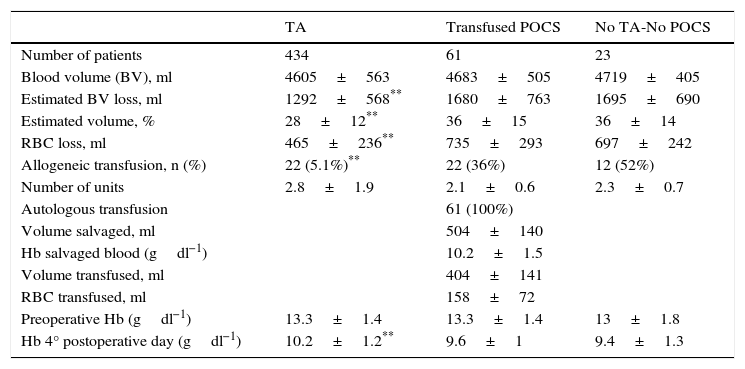Total knee arthroplasty (TKA) has a high transfusion rate. In our protocol, the use of postoperative cell salvage is indicated in patients with contraindications to tranexamic acid (TA). An analysis was performed on the effect of post-operative cell salvage (POCS) regarding transfusion rate and costs in patients undergoing TKA.
Material and methodsA prospective analysis was conducted on 518 patients, of whom 434 received TA, and 84 were contraindicated. The red cell mass, blood volume, and the percentage of lost blood volume were calculated. Incidents associated with the use of post-operative re-perfusion of drained blood and the rate of transfusion were recorded. An analysis was performed on the costs associated with allogeneic transfusion prevention methods.
ResultsA POCS drain was not inserted in 10 out of the 84 patients not candidates for TA. In the 74 in which it was placed, 158±72ml of red cell mass was reinfused. The allogeneic transfusion rate was 36%, and was 52% in those with no drain inserted. Relative risk of transfusion using POCS was 0.69 (0.41 to 1.16) with an absolute risk reduction of 16% (−8 to 40%). The number needed to treat to avoid allogeneic transfusion was 7. The direct costs to avoid allogeneic transfusion were €1610. No complications associated with blood re-infusion were observed.
ConclusionsThe use of POCS would be required in 7 patients after TKA to avoid one allogeneic transfusion with a cost over 10 times that of a transfusion of red cell concentrates.
La artroplastia total de rodilla (ATR) presenta una elevada tasa transfusional. En nuestro protocolo, indicamos el empleo del recuperador de drenajes postoperatorios (RDPO) en los pacientes con contraindicación al ácido tranexámico. Analizamos el efecto de los RDPO respecto la tasa transfusional y sus costes en pacientes intervenidos de ATR.
Material y métodosSe incluyeron prospectivamente 518 pacientes. De ellos, 434 recibieron ácido tranexámico y en 84 se contraindicó. Calculamos la masa eritrocitaria, el volumen sanguíneo y el porcentaje de volumen sanguíneo perdido. Controlamos las incidencias asociadas al uso del recuperador y la tasa de transfusión. Realizamos un análisis de costes asociados a los métodos de prevención de transfusión alogénica.
ResultadosEn 10 de los 84 pacientes no candidatos a ácido tranexámico no colocamos el RDPO. En los 74 en los que colocamos un RDPO, reinfundimos 158±72ml de masa eritrocitaria. La tasa de transfusión alogénica fue del 36%, y en los que no se colocó, del 52%. Con el empleo de RDPO el riesgo relativo de transfusión se situó en el 0,69 (0,41-1,16), con una reducción de riesgo absoluto del 16% (−8,-40%). El número de pacientes a tratar para evitar una transfusión alogénica fue de 7. Los costes tangibles directos para evitar una transfusión alogénica se situó en 1.610€. No observamos complicaciones asociadas a la reinfusión de la sangre recuperada.
ConclusionesEl empleo de RDPO tras ATR precisa de su empleo en 7 pacientes para evitar una transfusión alogénica, con un coste más de 10 veces superior al del concentrado alogénico.











